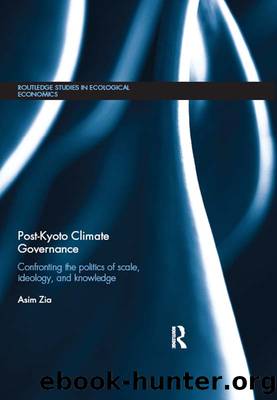Post-Kyoto Climate Governance by Zia Asim;

Author:Zia, Asim;
Language: eng
Format: epub
ISBN: 1125160
Publisher: Taylor & Francis Group
In 1988, Gigerenzer, Hell, and Blank further elaborated on the dynamics of representativeness heuristic. The authors specify a representativeness heuristic (neglecting to use base rates) as opposite from a strategy of conservatism (using only the base rate, and neglecting specific evidence), and further argue that a subject's use of base rates is rather determined by an internal mental model representing the problem, and thus not limited to either extreme approach. They posit that a Bayesian-type updating strategy is not appropriate for many everyday, real-life problem-solving instances, and they further hypothesize such a procedure can be induced based on effects of problem presentation and content (Gigerenzer et al. 1988).
In the first experiment, the authors recreated Kahneman and Tversky's (1973) engineer-lawyer problem, with a modification in which subjects physically witnessed the random sampling of descriptions (by drawing them from urns before responding to the appropriate prediction problem). The authors wished to examine whether witnessing randomness would induce a Bayesian-type mental model of the problem, or whether the same base rate neglect effects would be seen that were present in the original study. Ninety-seven students were split into two groups, one of which visually observed the random selection of the descriptions presented, and the other group was given only a verbal assertion of randomness as in the original study. The authors found that for the group that visually observed the random sampling, the deviation from a representativeness strategy increased from the verbal assertion group, and that deviation from a Bayesian-type prediction decreased with observance of random sampling (Gigerenzer et al. 1988).
Further, in the experiment, the subjects were asked to describe their strategies for arriving at their predictions and to describe how they chose to utilize the base rate information regarding the proportions of engineers and lawyers. The strategies were classified by two observers into five general categories: base rates only, Bayesian revision, Bayesian integration (where both types of information were considered, but not via revision), lexicographic representativeness (where similarity was considered first, and base rates were consulted only if necessary), and representativeness heuristic (where subjects followed the classic base rate neglect strategy). The choice of strategy was different depending on whether the subjects were in the verbal assertion or visual observation group. More than twice the percentage of respondents in the visual group reported following a base rate only strategy than in the verbal group. Similar percentages of respondents in either group chose the Bayesian revision and lexicographic strategies.
However, a significantly higher portion of the visual group chose a Bayesian integration strategy, and a significantly higher portion of the verbal group chose a representativeness heuristic strategy. These results support the difference that was observed in the predictions, that the visual group tended towards a Bayesian strategy, and the verbal group tended towards a representativeness strategy, further supporting the hypothesis that the presentation of the problem influences the subjects internal working model of the problem and the appropriate strategy of prediction (Gigerenzer et al. 1988).
The second experiment sought to explore the effects of content on the internal representation of prediction problems.
Download
This site does not store any files on its server. We only index and link to content provided by other sites. Please contact the content providers to delete copyright contents if any and email us, we'll remove relevant links or contents immediately.
International Integration of the Brazilian Economy by Elias C. Grivoyannis(74630)
The Radium Girls by Kate Moore(11619)
Turbulence by E. J. Noyes(7700)
Nudge - Improving Decisions about Health, Wealth, and Happiness by Thaler Sunstein(7240)
The Black Swan by Nassim Nicholas Taleb(6762)
Rich Dad Poor Dad by Robert T. Kiyosaki(6174)
Pioneering Portfolio Management by David F. Swensen(6078)
Man-made Catastrophes and Risk Information Concealment by Dmitry Chernov & Didier Sornette(5645)
Zero to One by Peter Thiel(5488)
Secrecy World by Jake Bernstein(4388)
Millionaire: The Philanderer, Gambler, and Duelist Who Invented Modern Finance by Janet Gleeson(4092)
The Age of Surveillance Capitalism by Shoshana Zuboff(3983)
Skin in the Game by Nassim Nicholas Taleb(3965)
The Money Culture by Michael Lewis(3846)
Bullshit Jobs by David Graeber(3826)
Skin in the Game: Hidden Asymmetries in Daily Life by Nassim Nicholas Taleb(3720)
The Dhandho Investor by Mohnish Pabrai(3560)
The Wisdom of Finance by Mihir Desai(3523)
Blockchain Basics by Daniel Drescher(3327)
